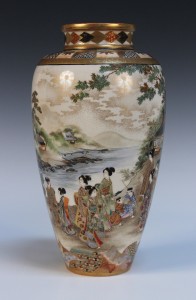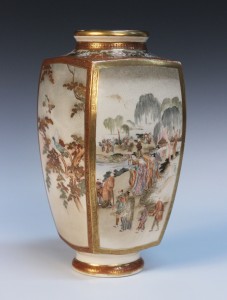
It is with a sense of anticipation and excitement that we are preparing to reopen Toovey’s auction rooms to the public. The ‘R’ number willing, and having already been postponed once, we will open on Monday 15th June.
Our first specialist auction will be a fine selection of Chinese and Japanese ceramics and works of art from across Sussex; it is already attracting strong interest internationally and from across the UK.
One of the pieces which is attracting the attention of collectors and specialist dealers alike is the remarkable Satsuma dish you see here which has a pre-sale estimate of £2000-£4000.
In contrast to the predominately agrarian society which preceded it, a vibrant community of merchants and businesses grew up in Japan’s towns and cities in the early and mid-19th century.
For the first time urban populations had the means and leisure time to support a new culture of theatres, geisha and courtesans. This search for pleasure became known as ukiyo (the floating world), an ideal world of fashion and entertainment.
The prints, netsuke and ceramics which would be exported to, and have such an influence on, the West were born out this cultural movement.
Satsuma ceramics are a quintessential expression of the Meiji period (1868-1912) which continues to delight the imaginations of western collectors and our sense of the exotic.
Satsuma ceramics met with great success at the Paris Exposition Universelle of 1867. The mature Satsuma style was introduced to Kyoto by Kinkōzan Sōbei VI (1824-1884) and the Awata district became the centre of Satsuma production. In contrast to earlier pieces Satsuma from the Meiji period was elaborately decorated and predominately produced for export. The extravagance of these designs contributed to its popularity in Western markets.
Wares produced in Kyoto were similar in style and taste to the Satsuma produced in other towns and cities like Osaka and Yokohama. Satsuma had become an aesthetic term rather than denoting place. Indeed popular themes were published and shared.
However, it was the painters’ skill, stylistic preferences and range of colours that gave a piece its individual character. The finest painters like Sozan at Kinkōzan cultivated distinctive and personal styles. Sozan whose red seal within a cartouche appears on the presentation dish illustrated is considered to be among the finest painters of his kind in Japan. Dated, documentary Satsuma earthenware, like this dish, is extremely rare.
Whilst the scene is characteristic of Satsuma the distinctive, exceptional quality and style of painting is typically Sozan. Two bijin (beautiful women) stand in conversation in an exquisitely conceived landscape as a child plays with a kite beside a river. In the distance Mount Fuji can be seen, with a village on the horizon.
Items produced by the Kinkōzan Sōbei porcelain company are marked ‘Kinkōzan’. However, some pieces also carry the name ‘Sozan’. Sozan was a painter of porcelain but it is commonly held that he was also responsible for the decorative schemes and designs on these pieces.
This exceptional dish will be one of the highlights in Toovey’s first sale of Japanese and Chinese ceramics and works of art since the lockdown. The auction is scheduled for mid-June.
All being well Toovey’s will reopen to the public on Monday 15th June 2020 so do email us to make an appointment to meet our valuers, virtually or in person.


